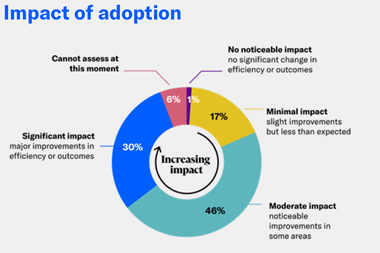Given the potential impact of injury or relegation, football clubs may not be taking risk management seriously enough. Lee Coppack watches from the bench.
It may be the beautiful game – but it is not the most beautiful of investments. Shares in UK football clubs are very much on the injured list. Prices for clubs such as Leeds United, Tottenham Hotspur and Newcastle United are now trading at around 20-30% of their peak values in 1999-2000.
"Investor interest is at an all time low", says analyst Stephen Ford of stockbroker Collins Stewart. Although clubs have experienced strong growth in all revenue streams throughout the last decade, turnover looks likely to plateau, while costs, notably spending on players, have continued to rise.
Even Manchester United – the only quoted club to show consistent profits – has not avoided the market's displeasure. In the early spring of 2000, the shares were trading around 400p. By December 2002 they had fallen to 100p, and the market capitalisation had dropped to £250m.
Yet many fans feel that the club managements are trying to propitiate professional investors to the supporters' disadvantage. The decision to grant an extra dividend to investors, taken at Manchester United's November 2002 AGM, did not please the Independent Manchester United Supporters Association (IMUSA) or Shareholders United (SU). SU spokesman, Oliver Houston described it as a "sickening" sweetener for the City. But, as Stephen Ford says, "Football fans are more likely to change their spouse than their team." And he looks to Manchester to give more consideration to shareholder returns.
Fans are the most important group of stakeholders in football. Unlike buyers of consumer goods, for example, they have not only a common interest but a mutual physical meeting ground. In the quoted clubs they may also be shareholders, and they are quite prepared to exercise their collective muscle against the wishes of the management, if they think it is to the long-term good of the club. In 1998, Manchester United shareholder fans successfully lobbied against the bid for the club by Rupert Murdoch's BskyB, contrary to the recommendations of the management.
Risk management on the bench
In the middle of these passions, risk management is not a priority, despite the importance placed on risk assessment as part of good corporate governance. The 2002 State of the Game report from the Football Governance Research Centre at Birkbeck College, University of London, surveyed quoted and unquoted public football clubs. It found that in 32% of the clubs the board did not regularly review risk reports; 30% said they had no controls or procedures to limit exposure to loss of assets or fraud. Three quarters had no audit committee.
The clubs' most valuable assets are their players and, in most cases, their stadium. The most substantial continuing commercial risks are loss of broadcasting revenues and the risk to broadcasting and other revenue-producing deals through failure to qualify for championships or through relegation.
As a quoted company, Manchester United confirms its compliance with the Turnbull guidance on risk management in its 2002 annual report. It does have an audit committee, composed entirely of non-executive directors. This committee meets twice a year, receives reports on the controls and strategies for dealing with each important risk, and reports its findings to the board. The board has decided that the size and nature of the business do not currently justify an internal audit function, but it is keeping the decision under review.
In a short statement on risks and commitments management in the report, Manchester United group finance director, Nick Humby, primarily covers financial exposures and player contracts. He also specifically mentions the risk of a player being permanently disabled from play – a risk which is insured. Says Humby: "In establishing what level of cover to purchase, the board considers the likelihood of a major claim, the club's excellent claims record, market capacity, pricing, the age of the players and an appropriate level of risk retention."
The risk of loss of a key player may be material to the financial health of the club. Deloitte & Touche's Annual Review of Football Finance explains that registrations for players bought for a fee from other clubs are treated as intangible assets and accounted on the balance sheet at net book value (NBV). The costs are then amortised over the life of the player's contract. During the 2000/1 season, Manchester United spent about £47m on just two men, Juan Sebastian Veron and Ruud van Nistelrooy. The balance sheet to 31 July 2002 shows player registrations of £82.2m out of total assets of £192.3m with amortisation of player registrations over the year of £17.6m.
Home grown players – like other internally generated intangible assets – are excluded from the balance sheet. Similarly, the Manchester United brand, possibly the best known sports brand in the world, does not appear. In a conventional company, threats to such a valuable asset would be high on the risk manager's list of concerns, especially where the management is extending it into new areas.
Manchester United not only has a following of about 50m fans worldwide, it is also rich and successful. This is the ideal mix to attract populist media coverage, and it does. The claim, soon thrown out of court as groundless, by a young woman in South Africa who accused Manchester United manager Sir Alex Ferguson of indecently assaulting her made front page headlines.
Players, likewise, suffer the same level of interest in their lives on and off the pitch. Misbehaviour makes headlines, but this sports brand is far more robust than a consumer brand. Many fans agreed with the £150,000 fine and five match ban imposed on team captain Roy Keane for bringing the game into disrepute. Some thought it should have been harsher. His behaviour will not stop them being Manchester United fans. As State of the Game comments: 'The relationship between supporter and club is very different to standard customer-company relationships.'
Out of the stadium
While some clubs do have a methodical process for assessing commercial risks, such as the collapse of ITV Digital, it appears that few, if any, have a professional risk manager. The UK risk management association AIRMIC has no individual or corporate members whose job is to manage risks for a sports club or organisation.
Instead of a risk manager, says Duncan Fraser of the sports unit at broker Marsh, some clubs have a risk panel, and the finance director is usually responsible for the insurance programme. "As an industry, football clubs are not very sophisticated in their approach to risk management. We would like to see them do more," he comments.
The permanent loss of a single expensive player through disability is clearly crucial; the insurance market is also concerned at the potentially catastrophic exposure of several players being killed or injured in the same incident. Of course, this happened to Manchester United in the 1958 air crash in Munich where half the team was killed and the other half seriously injured.
There are other material risks, some specific to football and others relating to the same types of exposures that other businesses that entertain large crowds have, points out Fraser. They include terrorism and crime.
A potentially substantial future risk is employers' liability for long term disability in players. Research by the University of Coventry in 1998 showed that of a sample of nearly 300 current and retired footballers 49% had osteo-arthritis, compared to 10% of men aged 35 to 44 in the general population. As many as 15% of the retired players were registered disabled. In December 2001, the British Journal of Sports Medicine published further research covering 185 retired players. It produced similar results.
"This is potentially an issue," comments Duncan Fraser. "It needs to be looked at seriously, especially as people have become more litigious. Marsh has a steering group working on it."
The insurance market for player incapacity is a small and centres on Lloyd's. According to Fraser, there has been a reduction in the number of insurers who will underwrite this key exposure, and premium rates have increased 25-30%. Perhaps this situation will concentrate the minds of football clubs on the value of risk management in the way that it has with other industries.
Fans would also certainly like to see a longer term approach. "Clubs need to be looking at their risk assessment like any business," says Simon Binns of Supporters Direct, the Supporters' Trust initiative.
Lee Coppack is a freelance writer and analyst specialising in insurance and risk management issues.
E-mail: lee@coppack.co.uk



















